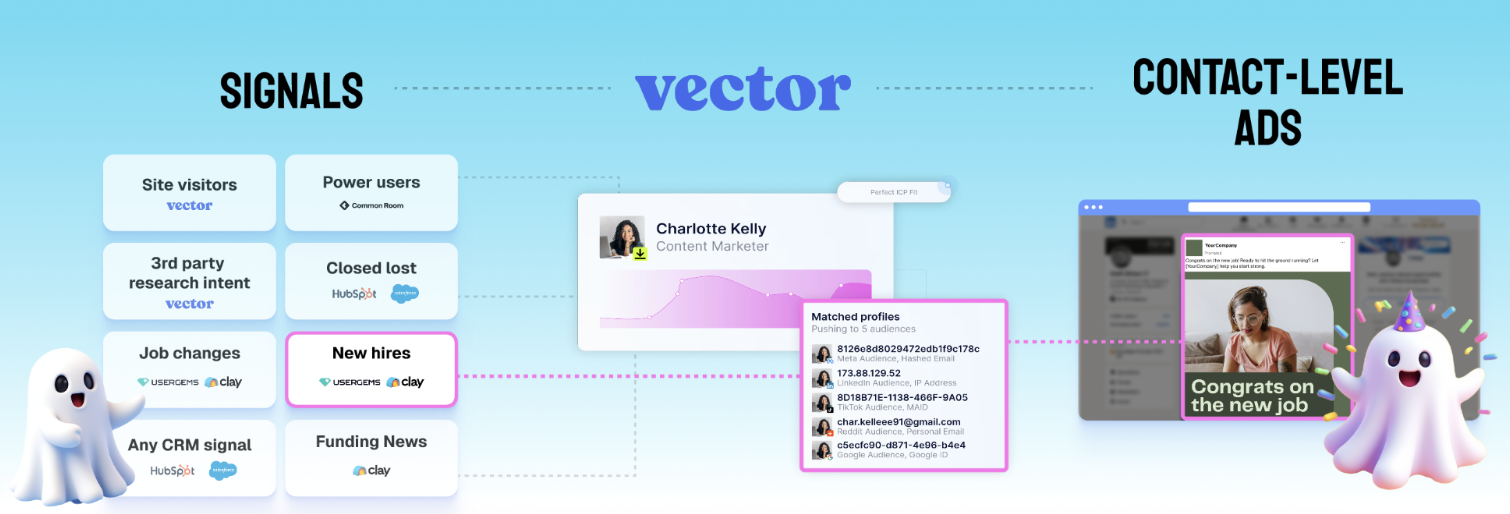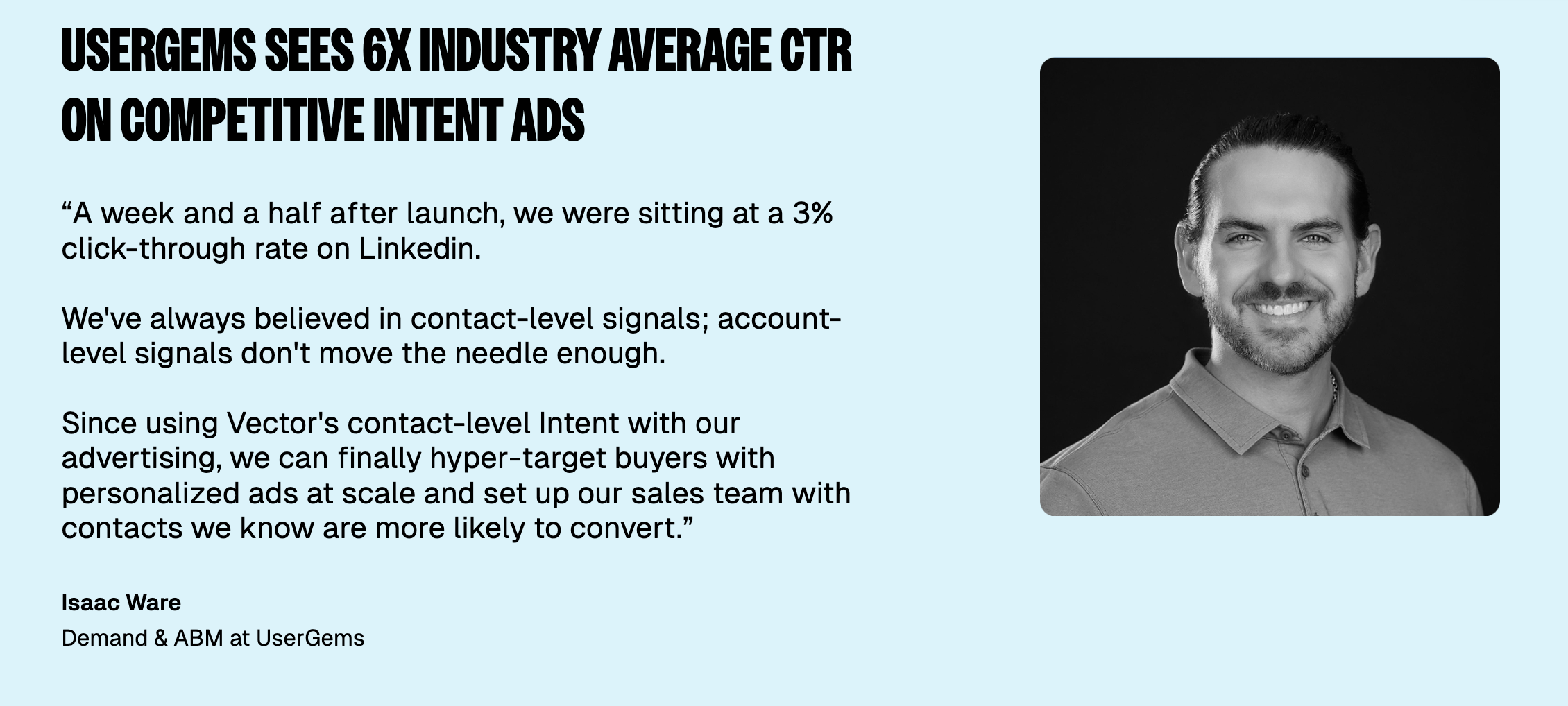Signal-driven ad audiences: turn any signal into real-time activation

Your signals are stuck. Let’s fix that.
Marketing teams are sitting on a goldmine of signal data:
- Job changes
- CRM segments
- Pricing page visits
- Intent spikes
And yet most of that gold gets buried in Slack threads, dashboards, and inboxes no one has time to read.
The problem for modern marketers isn’t a lack of signals; it’s a lack of activation.
As marketers, we’ve spent years optimizing how we collect data. But now GTM teams are stuck at the next frontier: doing something with it.
Have you ever faced any of these scenarios:
- Signals from CRM sit in static lists
- Sales is alerted days too late (if at all)
- Ad campaigns run without knowing who actually clicked
This is the core problem Signal-driven ad audiences was built to solve.
.gif)
The problem:
the inbox
The inbox was supposed to be the final mile for GTM teams. The place where intent turns into engagement. But that’s no longer the case.
Today, inboxes are overflowing with sequences, newsletters, pitch slaps, and cold emails that all blur together.
And the outcome of all this noise?
- Reply rates are dropping.
- Unsubscribes are increasing.
- Attention is non-existent.
- Your team is frustrated and burned out.
Meanwhile, one of the most powerful GTM levers, paid media, remains disconnected from those signals.
You know who’s in-market. You know what accounts are spiking. You know which contacts hit the pricing page twice in 24 hours. But you can’t reach them unless someone opens an email.
And increasingly, they don’t.
That’s the real problem.
.gif)
The Vector difference:
Signal in. Action out.

While other tools collect signals and let them sit, Vector flips the model: it turns those signals into real-time, contact-level campaigns, so you’re not just aware of buyer intent, you’re acting on it.
Signal-driven ad audiences are the proof point for contact-level advertising.
Here’s how Vector changes the game:
- Use any signal: Pull from CRM lists, job changes, intent triggers, or ad clicks. Wherever your signals live, Vector makes them usable.
- Build dynamic audiences: Automatically sync live contact-level segments to LinkedIn and programmatic channels. No more static exports or manual uploads.
- Reveal engagement: See exactly which known contacts clicked your ads, even if they didn’t convert. No more anonymous performance data.
- Trigger follow-up: Launch retargeting or alert sales the moment someone engages without waiting for a form fill or an SDR to notice.
- Measure impact: Track performance by segment, persona, and stage so you can prove what’s working and fine-tune what’s not.
Signal-driven ad audiences are not a better detection tool. It’s the GTM activation layer your funnel’s been missing.
Where other platforms stop, Vector starts: turning signals into motion across marketing, sales, and success.
See how UserGems is currently using signal-driven ad audiences.

Why this matters now
Most “signal-based” products stop at insight. You see who might be interested... and then what?
.gif)
That’s where Signal-Driven Ad Audiences are different:
- Clay, Common Room, Unify: Great for detection and sales activation, but not marketing activation
- 6sense, Demandbase: Great at accounts, not contacts
- Metadata: Focused on performance while Vector builds real-time, signal-based audiences with CRM, behavioral, and enrichment data
- Vector: Built to take any contact-level signal and do something with it automatically
Start here:
skip the sequence
If you’re relying on email to handle all your activation work, we understand. But it’s also your biggest blind spot.
Start simple:
- Replace one nurture sequence with a contact-level ad campaign using Signal-Triggered Ads.
- Use the same segment, same message in a different channel.
- Monitor what happens when you stop waiting for replies and start meeting buyers where they actually are.
We call it the Skip the Sequence Challenge. (And yes, it works.)
Here's what we mean:
1. Use any signal as a trigger
Pull from CRM lists, job changes, pricing page visits, intent tools, or Funnel Vision segments. Wherever your signals live, Vector makes them usable.
➡️ Example: UserGems uses job change signals from their platform to trigger ad campaigns in Vector, helping sales multi-thread faster and reach champions who’ve moved into new roles.
2. Auto-sync dynamic audiences to ad platforms
Build live, contact-level audiences that sync continuously with LinkedIn and programmatic platforms. No static exports. No manual uploads.
➡️ Example: Scrappy ABM ran a head-to-head test and found Vector delivered 40% more contacts, including a Director of Demand Gen missed by their previous vendor. Their next step? Use Vector to build always-on ad audiences straight from contact signals.
3. Reveal who engaged—even without form fills
Track ad clicks and impressions back to real people (not just anonymous engagement). See who’s interacting even if they don’t convert.
➡️ Example: Goldcast now de-anonymizes visits to registration pages and knows exactly who clicked their LinkedIn ads. If someone doesn't fill out the form, they still become part of a retargeting audience inside Vector.
4. Trigger automated follow-up actions
Launch retargeting or send alerts to sales the moment someone engages, no waiting for a form fill or SDR handoff.
➡️ Example: When visitors hit Goldcast’s event pages but don’t register, they’re instantly added to a nurture audience via LinkedIn ads without needing to opt in.
5. Track performance by persona, segment, or stage
Get clear attribution and impact data at the contact level. Know what’s working, who’s engaging, and where to optimize.
➡️ Pro tip: Start with one segment (like open opps or pricing page visitors) and monitor how signal-driven ads perform vs. traditional email sequences.
In conclusion, signal-based marketing only works if you can act on the signals.
Signal-driven ad audiences make that possible.
No more inboxes. No more static lists. Just real people, real signals, and real activation.
And we're not done yet.
.gif)
Ad targeting
doesn't have to be
a guessing game.
Turn your contact-level insights into ready-to-run ad audiences.


